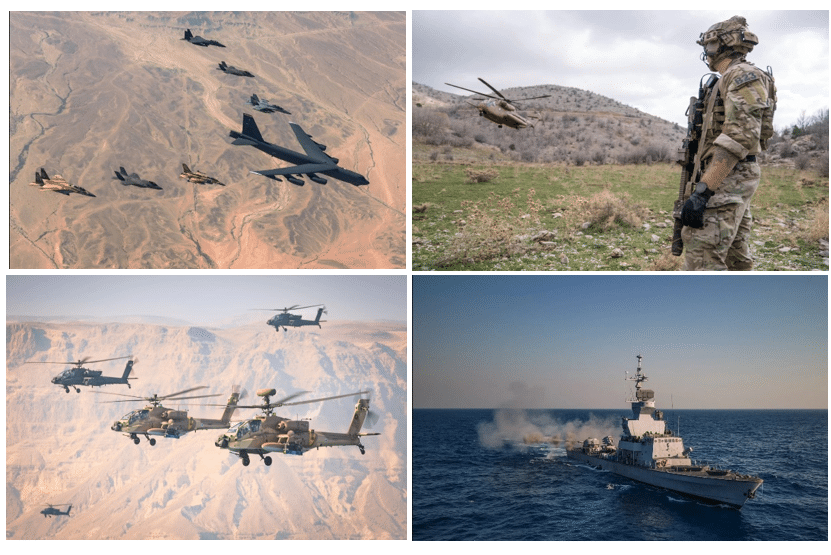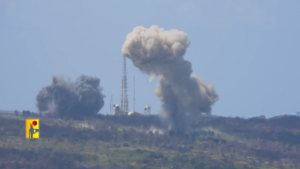Joint military exercises led by the United States with Israeli participation: the Security significance vis-à-vis the Iranian challenges:
The Juniper Oak 2023 exercise, conducted by the U.S. and carried out jointly with Israel (January 23), received increased media exposure, implementing a prominent show of military force. The exercise emphasized the in-depth cooperation between the countries facing the common threats and challenges posed by the radical Shiite axis led by Iran. The exercise also indicates an American readiness to work together with Israel throughout the region more openly and out of a desire to maintain the region’s stability.
Seven thousand nine hundred soldiers participated in the exercise (6,400 Americans and 1,500 Israelis), 142 fighter jets (100 American, 42 Israeli), and 12 battleships, including the USS George H.W. Bush Carrier.[1] As part of the expanded scope of the exercise, US officials emphasized utilizing space force assets.[2] According to official Israeli statements, these cooperations aim to learn from its most important partner – the U.S. These operational partnerships improve IDF’s ability to cope with various regional security challenges.
The exercise simulated “complex operational scenarios,” including aircraft and ships striking targets simulating maritime threats, including American B-52 bombers that dropped live ammunition in Israeli firing zones. The exercise demonstrated the joint ability of the armies to operate strategic tools while coordinating between the IDF and CENTCOM (US Central Command), which continue to integrate learning processes for future exercises with other partners.
In January 2021, according to the United States Unified Command (UCP) program, it was decided to reposition Israel from the European Command Area of Responsibility (USEUCOM) of the US Army (AOR) to the Central Command of the US Army (USCENTCOM). This move recognizes Israel as a vital and senior partner in regional security and, even more important, in the willingness of US Arab allies to cooperate with Israel.[3]
Recently, the IDF and the US Army conducted another exercise called “Cyber Dome” aimed at training the cyber defense capabilities of both countries. The IDF’s Cyber Defense Directorate conducted the exercise in cooperation with the US Cyber Command.
These exercises are conducted against the backdrop of the region’s frequent and growing challenges, especially in light of Iran’s progress toward military nuclear capability. In addition, in the past year, and especially in recent months, there has been an increase in UAV, rocket, and IED attacks against American soldiers and facilities in Iraq and Syria, such as the attack on the U.S. base in al-Tanf, which was attacked two days before the joint exercise. It is still unclear whether the U.S. military retaliated to this attack. Iran’s actions and intentions to gain a foothold in Iraq are also receiving American attention. The American target bank and possibilities in the region remain relatively high. However, it depends more on the priorities of the U.S. administration rather than on the lack of targets to retaliate to. The joint Israeli-American exercises are also taking place against the setting of Iran’s ongoing military and civilian entrenchment in the Middle East, emphasizing Syria, Lebanon, and Yemen.
To strengthen its military capabilities in the Middle East, the U.S. Army, through CENTCOM, seeks to deepen partnerships with regional countries.[4] U.S. Air Force Commander of Air Forces Central Command Lt. Gen. Alexus G. Grynkewich pointed to the use of UAVs and other forms of innovation seen in the regional exercises to send a message of a show of force and proof of American commitment to its allies in the region. Grynkewich noted that Iran had planned to attack Saudi Arabia last year but had stood down when media reports about its intentions were leaked and after the U.S. sent F-22 fighter jets to the region.
The U.S. is also taking action against Iran’s smuggling corridor to the Houthis in Yemen in the Gulf of Oman region. The U.S. administration is considering transferring the weapons seized in this smuggling corridor in early January 2023 to the Ukrainians. These include more than 5,000 assault rifles and anti-tank missiles, also sending a message against Iran’s involvement in the war in Ukraine.
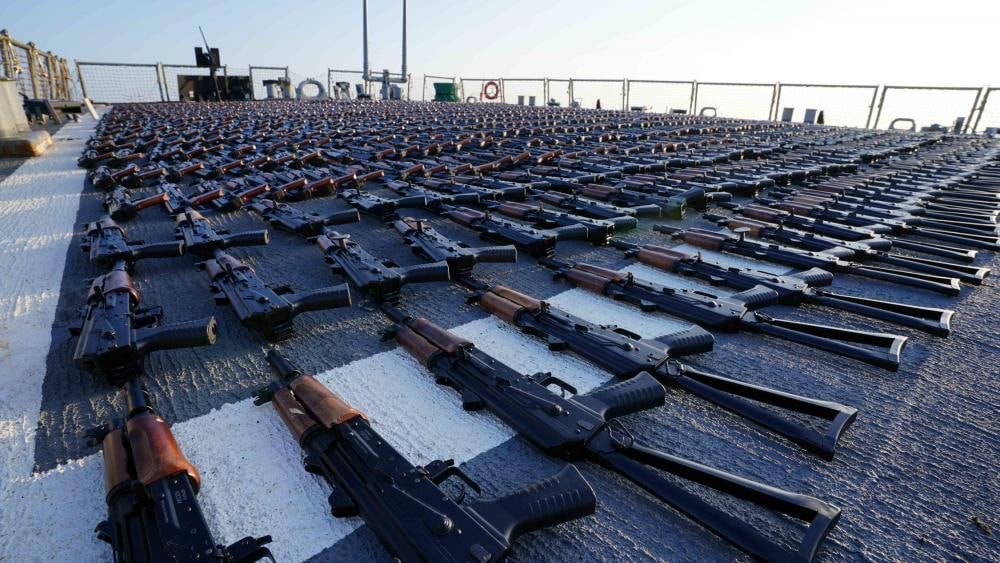
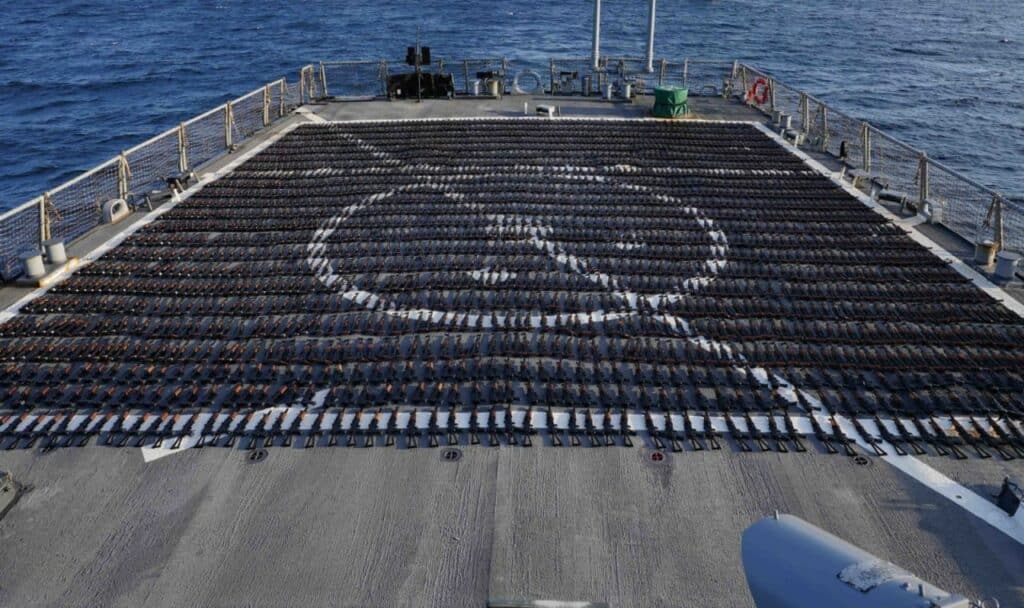
Above: Iranian weapons intended for Houthis in Yemen, seized by the US Fifth Fleet in January 2023
The growing cooperation between Russia and Iran will have long-term implications for the entire world and the Middle East region. The Iranians provide attacking UAVs to Russia (and possibly ballistic missiles), and in return, the Iranian regime may receive Su-35 Flanker fighter jets from Russia, which will increase the threat that Iran will pose to the region. In January 2023, Iran’s official media reported that Tehran was close to acquiring 24 advanced Russian Sukhoi Su-35 fighter jets.[5] Today, Iran has an outdated air force, which has not been renewed since the Shah’s regime and is problematic to operate for operational needs.
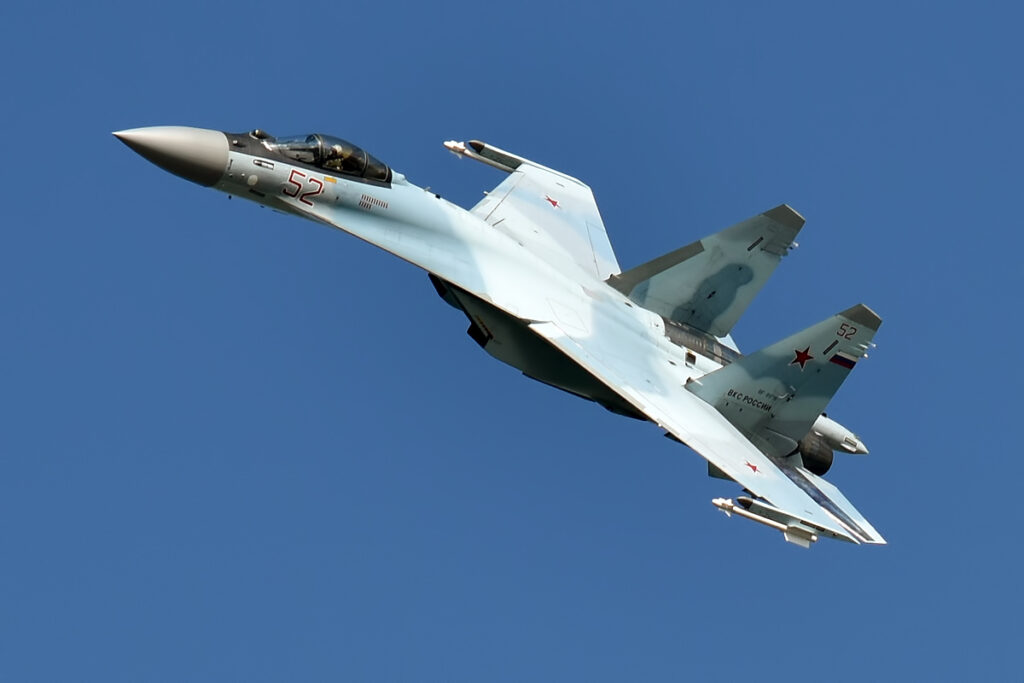
In this context, the growing concern is a change in the Iranian Air Force’s defense and operational capabilities. A series of OSINT[6] analysts, some of them independent, revealed the location of the underground facility presented by Iran (February 07) as part of its ability to conceal its air force facilities. The Iranians’ official announcement was intended, among other things, to show that it could withstand depth bombardments by the Israeli and American air forces, alongside the deployment of air defense systems. Joseph Dempsey,[7] a defense researcher at the International Institute for Strategic Studies, said the new base is located in southern Iran. Publicly available satellite images also show the process of building an air base that began in mid-2021 in the mountains in southern Iran and the creation of underground hangars on the base grounds. This base is located about 150 kilometers from Bandar Abbas. The videos and photos posted by the Iranians show a large network of tunnels with (outdated) Phantoms mobile inside them. The issue is not the planes but the impressive underground capability of the Iranians.
From this, we can understand the message that the Iranians wanted to convey by publishing these videos and photos regarding the survivability capabilities of their nuclear facilities in the context of the joint US-Israel exercises, whose goal is to prepare for a possible attack on such facilities.
Another counterweight against the Iranians, according to foreign media reports, indicates alleged American/Israeli cooperation with the Kurds in Iraq. Iran tried to exact a price through pinpoint attacks without much success. In this context, the relationship with the Kurds in Iraq became possible after the collapse of the Kurdish revolt in Iran, in which Iranian Kurdish parties fled to the Kurdish region in Iraq and established bases there. However, the regional government did not allow them to act against Iran from its territory, and even today, the extent of their activity in the region is limited.[8] Another offset is the expanding relations between Israel and Azerbaijan.[9]
The Abraham Accords and the expanding network of countries seeking to normalize relations with Israel embody many advantages not only in the military aspect but also in countries that seek to curb Iranian religious and ideological influence in the region and seek to distance themselves from this dangerous influence. These countries are lifting the embargo on military cooperation with Israel and are willing to promote more open relations that strengthen the American umbrella for the benefit of its allies.
These factors reinforce the assessment that the US will demonstrate its military and political capabilities in the region while supporting its allies against Iran. These actions will lead to military maneuvers alongside intelligence cooperation to understand the intentions of the hostile elements in Iranian leadership in the region.
[1] https://www.defense.gov/News/Transcripts/Transcript/Article/3279948/deputy-pentagon-press-secretary-sabrina-singh-holds-a-press-briefing/
[2] https://www.airandspaceforces.com/photos-us-israel-conclude-massive-exercise-with-f-35s-b-52s-and-more/
[3] https://besacenter.org/israels-future-in-multinational-coalitions/
[4] https://www.airandspaceforces.com/us-must-counter-china-and-russia-in-the-middle-east-afcent-boss-says/
[5] https://www.al-monitor.com/originals/2023/02/iran-shows-underground-air-base-russias-sukhoi-jets#ixzz7tTXbnCaL
[6] https://defence-blog.com/osint-analysts-geolocate-irans-secret-underground-airbase/?amp
[7] https://twitter.com/JosephHDempsey/status/1623301386069852160?cxt=HHwWgIC-gdKAkIctAAAA
[8] https://besacenter.org/he/%d7%90%d7%99%d7%a8%d7%90%d7%9f-%d7%9b%d7%95%d7%a8%d7%93%d7%99%d7%9d-%d7%9e%d7%99%d7%a2%d7%95%d7%98

